|
|
A/D 700 CONSTANTINOPLE, The Lucca Manuscript describes some little known forms of art, one called PICTURA TRANSLUCIDA Pictura translucida is painted with transparent pigments, mastic and turpentine. It was the next media winner after cera colla.
Byzantine used just the wax, mastic and turpentine. Egypt continued on with cera colla. The newer technique continued on with the Romans. Water based cera colla and Egypt lost that battle in the Paint Wars as mastic will lose to oil from the North. You can follow the Paint Wars in the main course link. It's a war about the best media and pigments, it's chronologically spaced through my RCW Color Course. Before Pictura Translucida there was this organic painting system called "cera colla", which is ammonia and wax, which makes a soap of emulsified bees wax paint. It could/should be called, Wax Soap, Wax Emulsion, Wax Painting, Cera Saponificata, Saponified Wax or Sapone di Cera.
At this time the Western Mediterranean only copied Egypt's art leadership.
Ammonia, NH3, is a compound of nitrogen and hydrogen, a water soluble gas. Ammoniac is a salt and gum found in the Qattara Depression 200 miles East of Memphis, Egypt. Ammoniac is the remains of a long extinct insect that lived in the area. Ammonium, is the Egyptian city founded about 500 B/C, as a shrine to their god Ammon. Ammonia is also NH4, a radical that plays the part of a metal in the compound formed when ammonia reacts with acids, ammonium salts are alkaline. Ammonium hydroxide, basic NH4OH is a weak alkali. Carbonate, a salt of carbonic acid, as calcium carbonate or ammonium carbonate, made by mixing the ammonium alkali with carbonic acid. H2C03 is formed when carbon dioxide dissolves in water. Ammonium carbonate or ammonium hydroxide both will make Cera Colla. I used a common 'Industrial Specification' 10% ammonium hydroxide as ammonia water, I found the 10% ammonia at Ace Hardware and diluted it 1:1 with more water.
The mixture will expand 10 times larger as it effervesces. Keep stirring it until the reaction subsides and remove it from the heat. Keep stirring for seven more minutes as it cools down. It will become more viscus and finally It should be as smooth and creamy as whipped cream.
You can make a more soupy paint consistency by adding more water and ammonia in the first stage.
TIP: Make the consistency you want with the amount of ammonia liquid you add to the melted wax, not after it sets. 1:1 is a good storage consistency, 1:2 is more like a heavy paint. From my "storage" consistency, ceracolla=1:20=water, this is probably what my brush takes it down to. 1st. The first photo is melting beeswax in a thick pot, being heated on a gas stove. The pot is in an aluminum pie tin with water in it. That will keep the temperature from getting too hot.
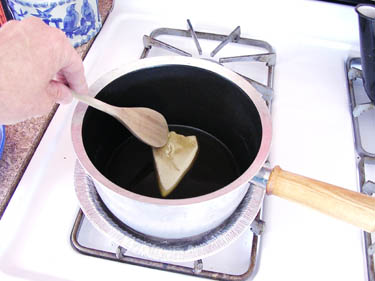 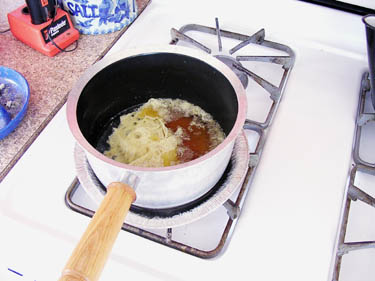
3rd, is the way it should look peak expanded, the photo is while the effervescence expanding is happening. 4th, is the mass shrinking.
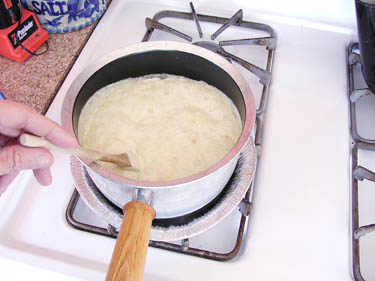 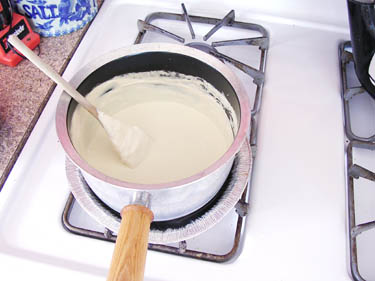
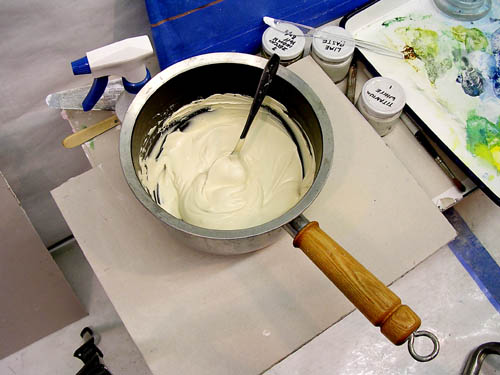
As long as we keep it this wet or wetter it will store for a very long time. It won't re-wet or dissolve in water after it's dry because it will have turned back into wax again, along with any pigment mixed in.
Sunlight came with Giotto 1300, Italy, added a little cherry gum to the cera colla and the Byzantines added a little "milk of fig". This is the ancient "cera colla' paint of the Dark Ages.
This will be the early Egyptian water soluble, wax soap emulsion for pigments, it will mix with casein, gum, glue, egg, gelatin, turpentine, resin, balsam, shellac or oil. The volatile ammonia alkali dissipates while drying and the soap dries insoluble to water wax, like it was before you started. Put a cap on the container and it will store for a very long time. Grind your store bought dry pigments into it as you need them. I would like to attribute the discovery of this medium to Egypt and their god Ammon not to Byzantium. They both used the medium a lot, and Egypt owned the world's supply of ammonia. All cera colla works were destroyed in the Iconoclastic Movement. Potassium carbonate or caustic lye soda, is obtained in the impure form from wood ashes, potash [+IUM], are all the same alkali. It will also emulsify wax, but it will remain soluble in water, it's hygroscopic. Other mediums Gotto talked about in the Lucca Manuscript were; stic-lac and borax mixed, this made an India water based paint. Gilding gums, alum, as used in dyeing, egg and wax emulsions, and the exceptional Chios resin paintings. None of the paintings of this time survived. Heraclius also wrote about art at this time, he wrote about oil paints, and egg white plus alum, for miniature painting. I think the Egyptian Fayian Grave paintings were done with cera colla, not the encaustic hot wax method attributed to them by some. Cera colla is better suited for portrait painting, they look like brush strokes to me. Here is an example of cera colla, the wax paint from the time of the Dark Ages.
Cera Colla 01, 5.5x7.5 Well here it is 5 years later, 09-20-04.. I learned to work in Buon Fresco and am merging these two ancient mediums as they once were. I'm going to really give this medium a workout, thick to thin, painted on dry and wet. Scraped and heat added, it will be fired upon. I just painted in the background and knifed in parts, I'm letting it dry now. 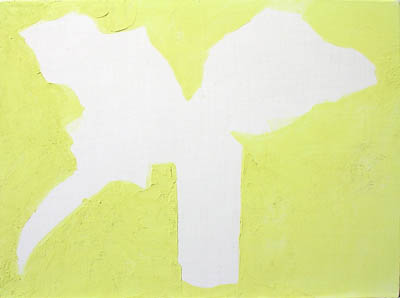 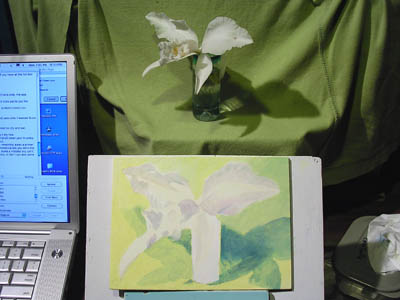
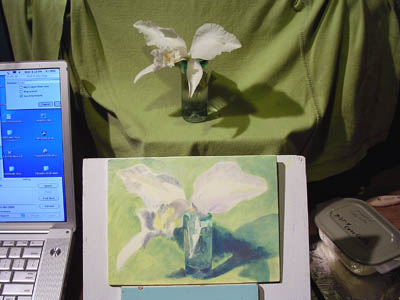 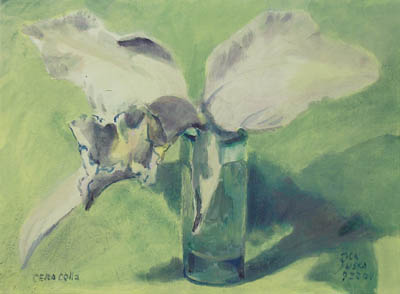 PIGMENTS: Nickel Titanium Yellow Opaque (zinc yellow hue), titanium white, viridian, transparent cyan, transparent warm magenta. A triad plus one. It seems like there is a working time of maybe an hour. That's when nothing moves. But you can still scrape! Two hours later I could stain but not move the under layer.
I held my lighter over an area on the left bottom, it got darker as the wax melted and became shinny and exposed the lower layers. I finished the little cera colla and set it aside to dry. In the morning it was still fragile so I put it in the sun to melt and solidify it. It sat in the sun for 5 hours and the wax was soft. I dipped the whole panel in water and rubbed it down with my fingers, then a soft rag and water. It does glow, I have a permanent painting that will not change colors ever, only wax media can say that, acrylics will probably past the time test too. This is a perfect medium for an out of reach location in a home. It can take the outside, it melts, feels and protects like wax. Today, there are trace remains of colored wax on the Trojan Column in Rome, from wax that was cured by boiling it in salt water. Ok! I got it.. First put down a clear layer of cera colla or two. Let it set. Now you can work down to dry and still be on wax. Paint another layer and paint on the wet pigment with ammonia water. You can always add another layer of cera colla on top of it wet or dry. On top of the pigment layer paint on more clear cera colla layers, one or two. Make it as thick as you want, it won't crack. The sun or a warm day will farther fuse it. Time is waxes friend. 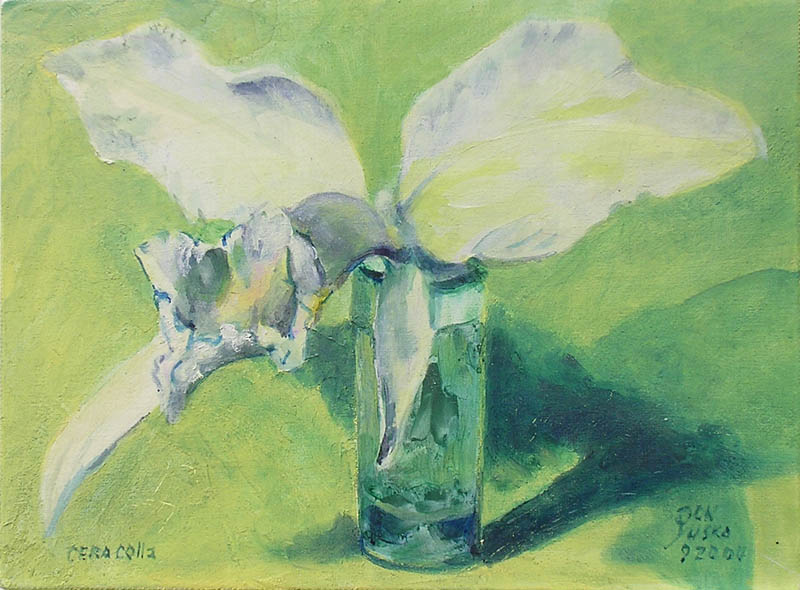
Ready to paint another cera colla painting.. Start looking for a subject.. 9-22-4. HA.. the next morning I started. Start, 11:15 AM. I'm using my oil painting set of brushes because the final cleaning is with turpentine. The best sable brush for this type of laying in color, I think, is one of my old Series 7, #8's that I squashed the ferule on and made a filbert of it. Drawing, to make the drawing I first wet the whole board down with media. The next brush load is what you have to paint with. This is your drawing technique and your painting technique. 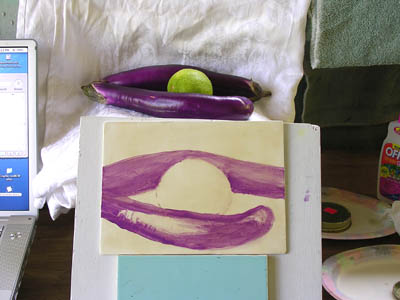 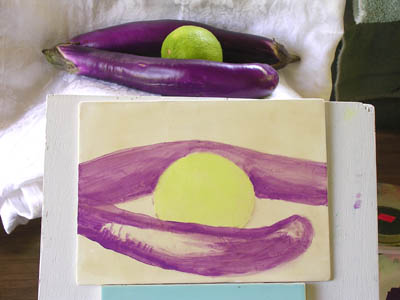 Get a brush load and work it to a painting a consistency. Pick up your pigment and paint in your outlines. Paint with that load only. Thin it down with ammonia as you pick up more pigment, until you are out of the last bit of medium in the brush before starting over with a new load and a new color. Like water colors, there is a drying stage for each stroke applied. Dry, before painting over or it will move. On dry cera colla you can lay a line that can be removed down to the dry again. 12:27 Manganese violet drawing and intensity scale with one color. I finished modeling the lime in three 'one brush load' colors. Pridrerit Yellow is a light yellow/green, that's the yellow primary in this TRIAD. Manganese violet is the magenta side primary and thalo blue cyan which means PB15.3 from Sinopia and just PB15 to Grumbacher. 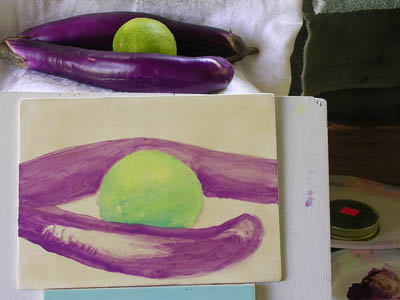 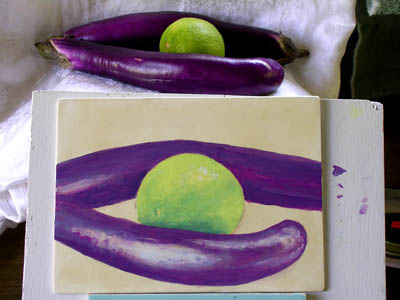 1:08pm. Next color was white, all the highlights, I should have painted a layer of white and medium on the dry troweled layer because the wax is virgin wax colored. 1:29pm. Blending with a wet sable and a dry bristle brush, painting with the sable. Next will be my darkest darks and background. Lay it in the sun for a while and give it another thin layer of clear cera colla, this layer is for burnishing it to a shine, spit shine if you know how. 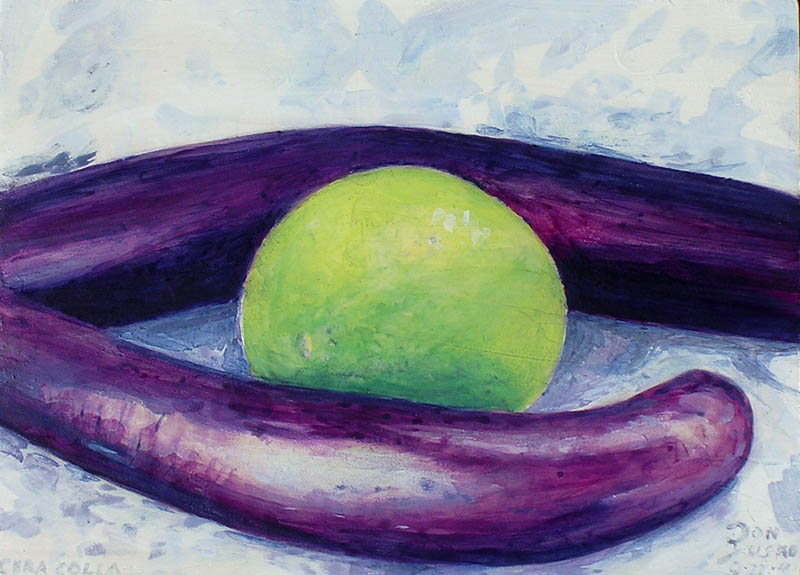
Colored Wax was used in the past to decorate carved statues. Shishi (or Jishi) is translated as "lion" but it can also refer to a deer or dog with magical properties and the power to repel evil spirits. A pair of Shishi traditionally stand guard outside the gates of Japansese Shinto shrines and Buddhist temples (although temples are more often guarded by the Nio Protectors). Shishi are depicted with their mouth open (to scare off demons) or closed (to shelter and keep in the good spirits). Another traditional explanation for the open/closed mouth relates to Ah and Un ("Ah" is the first letter in the Sanskrit syllabary and symbolizes open mouth, while "Un" is the last letter and it represents a closed mouth. The same holds true for the Japanese syllabary). The combination is said to symbolically represent birth and death. This mythical beast was probably introduced to Japan from China and/or Korean in the 7th or 8th century AD, during the same period as Buddhism's transmission to Japan, for the Japanese shishi combines elements of both the Korean "Koma-inu" (Korean dog) and Chinese "Kara-shishi" (Chinese lion). One prominent theory holds that the shishi derives from the Chinese Foo Dog. Lions, by the way, are not indigineous to Japan, China or Korea, and supposedly entered those nations in the form of imported art and sculpture, with the earliest traces of the animal appearing in China's Han Dynasty (about 208 BC to 221 AD). In China, the lion is the master of all felines, the defender of law, and the protector of sacred buildings. It is a symbol of power and success, and of royality and strenghth. Images of it were embroidered on court robes. In Korea, the skin on Koma-inu's head was believed to be stronger than a helmet. In Japan, the shishi is a noble beast who protects the entrace to the temple/shrine, and in some cases, the tomb. Shishi nearly always come in mated pairs (male and female). Helena Burton at Oxford University says the shishi is sometimes tattooed on a woman's belly to protect her during childbirth. Occasionally, Buddhist deities are depicted mounted on the beast. The truth is that back in Japan's Heian and Kamakura periods (from the late 8th through 14th Centuries), the lion dogs were placed, not outside, as they are today, but inside, under the roofs of the gate or the shrine buildings. In those days, almost all the buildings and Buddhist or Shinto sculptures were made of wood, so naturally the lion-dogs were too! Later, when the lion-dogs were placed outside, they began to be made of stone, in order to better withstand the elements. 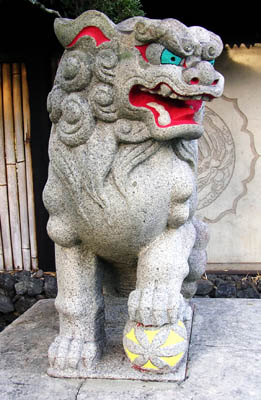 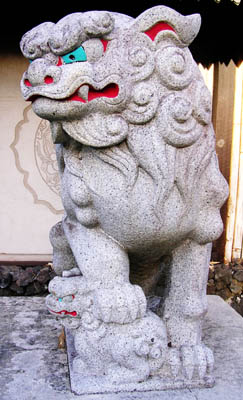
"The painting of the Dark Ages. Byzantine Indian Water Varnish w/ lac, plant & mineral colors called Pictura Translucida. Shellac & ammonium carbonate, mastic varnish."
|
NEXT, Oluwalu Coast Rocks, showing complementary color tips.
PREVIOUS, Painting fast in oil, Nahiku, Tom's Driveway

|
|